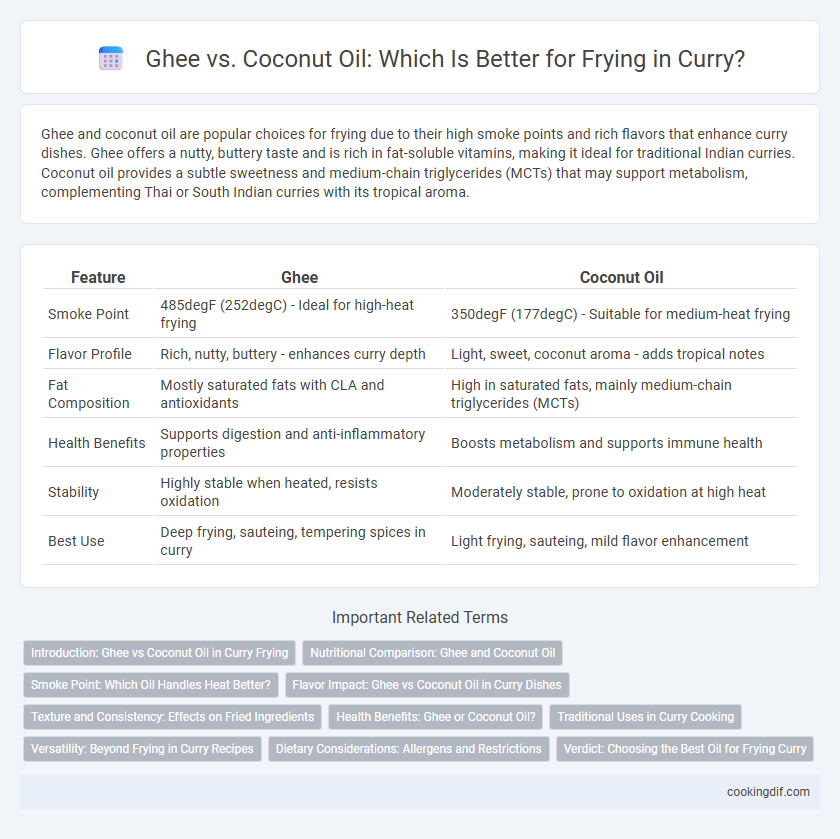Ghee and coconut oil are popular choices for frying due to their high smoke points and rich flavors that enhance curry dishes. Ghee offers a nutty, buttery taste and is rich in fat-soluble vitamins, making it ideal for traditional Indian curries. Coconut oil provides a subtle sweetness and medium-chain triglycerides (MCTs) that may support metabolism, complementing Thai or South Indian curries with its tropical aroma.
Table of Comparison
| Feature | Ghee | Coconut Oil |
|---|---|---|
| Smoke Point | 485degF (252degC) - Ideal for high-heat frying | 350degF (177degC) - Suitable for medium-heat frying |
| Flavor Profile | Rich, nutty, buttery - enhances curry depth | Light, sweet, coconut aroma - adds tropical notes |
| Fat Composition | Mostly saturated fats with CLA and antioxidants | High in saturated fats, mainly medium-chain triglycerides (MCTs) |
| Health Benefits | Supports digestion and anti-inflammatory properties | Boosts metabolism and supports immune health |
| Stability | Highly stable when heated, resists oxidation | Moderately stable, prone to oxidation at high heat |
| Best Use | Deep frying, sauteing, tempering spices in curry | Light frying, sauteing, mild flavor enhancement |
Introduction: Ghee vs Coconut Oil in Curry Frying
Ghee and coconut oil are both popular fats used in curry frying, each contributing distinct flavors and health profile benefits. Ghee, clarified butter with a high smoke point around 250degC, lends a rich, nutty aroma that enhances traditional Indian curries. Coconut oil, rich in medium-chain triglycerides and with a smoke point near 177degC, imparts a subtle sweetness ideal for South Indian and Southeast Asian curry varieties.
Nutritional Comparison: Ghee and Coconut Oil
Ghee contains higher levels of saturated fats and fat-soluble vitamins A, D, E, and K, supporting nutrient absorption and bone health, while coconut oil is rich in medium-chain triglycerides (MCTs) that promote quick energy metabolism. Ghee has a higher smoke point around 485degF, making it more stable for high-temperature frying compared to coconut oil's smoke point near 350degF, which can degrade beneficial compounds at high heat. Both fats offer unique health benefits, but ghee's vitamin content and heat stability make it a superior choice for maintaining nutritional value during frying.
Smoke Point: Which Oil Handles Heat Better?
Ghee has a higher smoke point of around 485degF (252degC), making it ideal for high-heat frying in curry preparation without breaking down or producing harmful compounds. Coconut oil's smoke point is lower, approximately 350degF (177degC), which suits medium-heat cooking but risks burning at higher temperatures. Choosing ghee over coconut oil ensures better heat stability and flavor retention when frying spices and ingredients in curries.
Flavor Impact: Ghee vs Coconut Oil in Curry Dishes
Ghee adds a rich, nutty flavor to curry dishes, enhancing the complexity and depth of traditional Indian spices. Coconut oil imparts a subtle, sweet, and tropical aroma that complements South Indian and Thai curries, creating a lighter and fruitier taste profile. Choosing between ghee and coconut oil significantly influences the overall flavor, with ghee providing a buttery richness and coconut oil offering a fresh, exotic nuance.
Texture and Consistency: Effects on Fried Ingredients
Ghee imparts a rich, buttery texture to fried ingredients, resulting in a crisp outside with a tender inside due to its high smoke point and clarified butter properties. Coconut oil produces a slightly lighter, flaky texture with a subtle sweetness that enhances the natural flavors of the food, while maintaining consistent heat distribution. Both fats maintain moisture well, but ghee tends to create a more uniform golden crust compared to the delicate crispness achieved with coconut oil.
Health Benefits: Ghee or Coconut Oil?
Ghee contains butyrate, which supports gut health and reduces inflammation, making it beneficial for digestion during high-heat frying. Coconut oil is rich in medium-chain triglycerides (MCTs), known to boost metabolism and provide sustained energy, but its higher saturated fat content may raise cholesterol levels. Choosing between ghee and coconut oil depends on dietary needs, with ghee offering anti-inflammatory properties and coconut oil promoting metabolic health.
Traditional Uses in Curry Cooking
Ghee has been traditionally used in Indian curry cooking for its rich, nutty flavor and high smoke point, which enhances the depth of spices without burning. Coconut oil, favored in South Indian and coastal cuisines, imparts a subtle sweetness and aroma ideal for seafood and vegetable curries. Both fats play a crucial role in authentic curry preparations, with ghee offering a buttery finish while coconut oil provides a lighter, tropical essence.
Versatility: Beyond Frying in Curry Recipes
Ghee offers rich, nutty flavor and high smoke point, making it ideal for sauteing spices and frying ingredients in curry dishes, while its buttery aroma enhances the overall taste profile. Coconut oil provides a subtly sweet, tropical undertone that complements many South Indian and Thai curries, and its medium-chain triglycerides offer health benefits beyond cooking. Both fats are versatile beyond frying: ghee can be used for roasting and as a finishing drizzle, whereas coconut oil excels in baking, dressings, and infusing curry sauces with creamy texture.
Dietary Considerations: Allergens and Restrictions
Ghee is lactose-free and suitable for those with dairy sensitivities, but it is animal-based, making it unsuitable for vegans and strict vegetarians. Coconut oil is plant-based and free from common allergens like dairy and gluten, making it ideal for vegan and allergen-sensitive diets. Both oils have high smoke points, but coconut oil may trigger allergies in individuals with tree nut sensitivities.
Verdict: Choosing the Best Oil for Frying Curry
Ghee offers a high smoke point and rich, nutty flavor that enhances the depth of curry dishes, making it ideal for frying spices without burning. Coconut oil provides a distinct tropical aroma and medium smoke point, which complements certain South Indian and Thai curries while maintaining moisture. The best choice depends on the desired flavor profile and cooking temperature, with ghee preferred for robustness and high-heat frying, and coconut oil suited for milder, aromatic curries.
Ghee vs Coconut oil for frying Infographic

 cookingdif.com
cookingdif.com